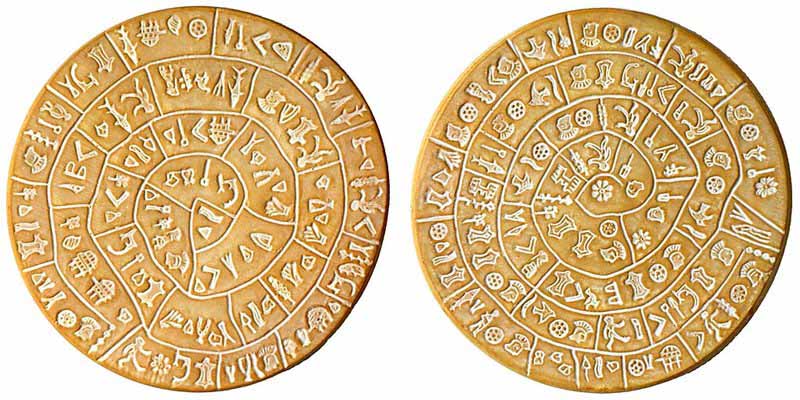
Phaistos
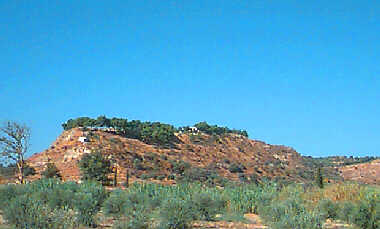
Phaistos - also Phaestos and Phaestus - was an ancient city on the island of Crete. Map of Minoan CretePhaistos was located in the south-central portion of the island, about 3 1/2 miles from the sea. It was inhabited from about 4000 BC. A palace, dating from the Middle Bronze Age, was destroyed by an earthquake during the Late Bronze Age. Knossos and other Minoan sites were also destroyed at that time. The palace was later rebuilt toward the end of the Late Bronze Age. The area upon which Phaistos stood was the site where, in 1908, a curious clay disk, dating to about 1700 BC, and containing a sophisticated pictographic writing, was discovered.
The Phaistos Disk is a curious archaeological find, most likely dating from about 1700 BC. Its purpose and meaning, and even its original geographical place of manufacture, remain disputed, making it one of the most famous mysteries of archaeology.
The Phaistos Disc was discovered in the basement of room XL-101 of the Minoan palace-site of Phaistos, near Hagia Triada, on the south coast of Crete. Italian archaeologist Luigi Pernier recovered this remarkably intact "dish", about 15 cm in diameter and uniformly just over 1 cm thick, on July 3, 1908.
Luigi Pernier discovered the disc during his excavation of the first Minoan palace. It was found in the main cell of an underground "temple depository". These basement cells, only accessible from above, were neatly covered with a layer of fine plaster. Their context was poor in precious artifacts but rich in black earth and ashes, mixed with burnt bovine bones. In the northern part of the main cell, a few inches south-east of the disk, and about twenty inches above the floor, linear A tablet PH-1 was also found. The site apparently collapsed as a result of an earthquake, possibly linked with the explosive eruption of the Santorini volcano that affected large parts of the Mediterranean region ca. 1628 BC.
Physical Description
The inscription was made by pressing pre-formed hieroglyphic "seals" into the soft clay, in a clockwise sequence spiralling towards the disc's center. It was then baked at high temperature. There are a total of 241 figures on the disc.
Many of the 45 different glyphs represent easily identifiable every-day things, including human figures, fish, birds, insects, plants, a boat, a shield, a staff, etc. In addition to these, there is a small diagonal line that occurs underneath the final sign in a group a total of 18 times. The disk shows traces of corrections made by the scribe in several places.
The Text
Although there is no official Unicode encoding for the symbols on the disk, the ConScript Unicode Registry has assigned a block of the Unicode Private Use Area to be used for the script. Two fonts include support for this area; Code2000 and Everson Mono Phaistos. The text on the disk is given on the second of these links; you can read that text if you have either of them installed.
The Strokes
There are a number of glyphs marked with an oblique stroke, the strokes are not imprinted but carved by hand and are attached to the first or last sign of a "word", depending on the direction of reading chosen. Their meaning is a matter of discussion. One hypothesis, supported by Evans, Duhoux, Ohlenroth and others, is that they were used to subdivide the text into paragraphs, but alternative meanings have been offered by other scholars.
Direction of Reading
From the diverse epigraphical facts (overcuts, angulous points of the spirals, corrections, etc.), it can be shown that the text has been written from the exterior to the center. The fact that most of the corrections were done on the spot, and other epigraphical facts, are showing that the scribe was "composing" his text in proportion as he was printing it. There is therefore no way to dissociate the direction of printing from the direction of reading.
Attempted Decipherment
A great deal of speculation developed around the disc during the 20th century. The Phaistos Disc captured the imagination of amateur archeologists. Alas, some of the more fanciful interpretations of its meaning are living classics of pseudoarchaeology.
Many attempts have been made to decipher the code behind the disc's glyphs. Historically, almost anything has been proposed, including prayers, a narrative or an adventure story, a "psalterion", a call to arms, a board game, and a geometric theorem. While many enthusiasts still believe the mystery can be solved, scholarly attempts at decipherment are thought to be unlikely to succeed unless more examples of the glyphs turn up somewhere, as it is generally thought that there isn't enough context available for meaningful analysis.
This general opinion is nevertheless disputed by several scholars on the basis of the work of the mathematician Claude Shannon. Shannon theory about the Unicity distance states that, in theory, the text's length is sufficient for reaching only one decipherment that makes sense. The problem is, however, that once there are reasons to think that a valid solution has been found, it is necessary to verify this solution by all means possible (generally by deciphering another text written in the same script), to be sure about it. Unfortunately until today no second disc was found, what makes the verification difficult.
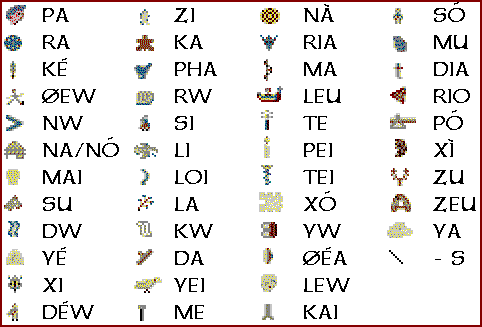
Some of the symbols were pictographs which means they represented the object depicted. Others functioned as ideograms in which the picture of, say, a boat, no longer means "boat" but expresses an idea like "travel". However, such associations of the object with its main qualities, uses, or features were usually direct, quite obvious, and widely recognized. Pictographs and ideograms are also usually much easier to understand intuitively than the syllabic and/or phonetic systems of writing which evolve from them as a means of expressing more abstract ideas in a particular language.
The uniqueness of this archaeological object is contested by at least two other apparently related specimens - a votive double axe found by Spyridon Marinatos in the Arkalohori Cave, Crete, and a fragment of a smaller clay disk, found at Vladikavkaz, North Ossetia. But both inscriptions were engraved, not made with stamps. Moreover, the first contains only superficially similar hieroglyphics, and the second, interesting as it might prove, disappeared mysteriously. So far, the Phaistos Disc remains a hapax.
This unique object is now on display at the archaeological museum of Heraklion in Crete, Greece.
Reference: Thomas Balistier The Phaistos Disc - An Account of its Unsolved Mystery
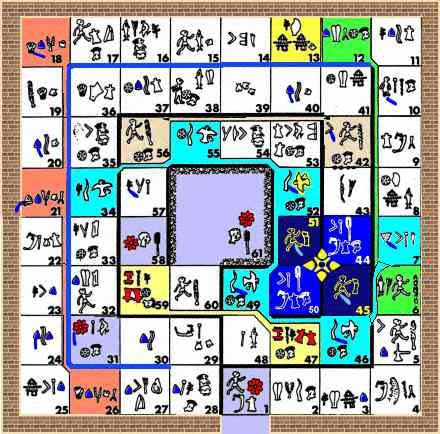

Portal or Stargate
The Phaistos Disk, along with other artifacts that are surfacing in recent years, are coming to light as means of triggering our awareness about the shift in consciousness at this time. Much of the symbolism on the artifacts found deal with the theme 'Death and Rebirth' as consciousness is about to shift into something new. All things in our reality are metaphors - this 'game board' / disc and its symbols being no different.
The disk links with the number 6 ----> the Star of David - Merkaba ----> the spiraling movement of consciousness in and out of this reality - Sacred Geometry .
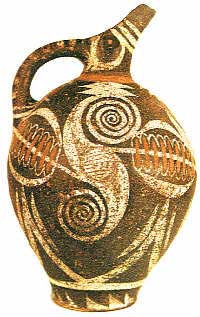
The Spiral Pattern is Repeated - Above and Below
One could try to explain the primitive pictures as sacred script in which archaic forms often survive, as happened in Egypt long after linear characters were employed for secular purposes. However, none of the missing links in this postulated evolution have been found. The famous Narmer Palette from the beginning of Egypt's first dynasty is a typical example of such early emblem and rebus writing. It contains a few hieroglyphs as writing signs used for their phonetic value, but most of the signs on it are pictographic symbols that mean the object depicted.
As we live in duality - the nature of our mission is to create balance and reunite with that which is our twin aspect - reunion with our twin soul on the other side - male/female - As is Above - So is Below - The Emerald Tablets of Thoth - Hermes Trismegistus
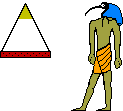
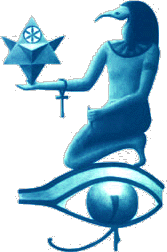
Geometry of Creation
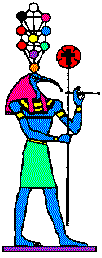
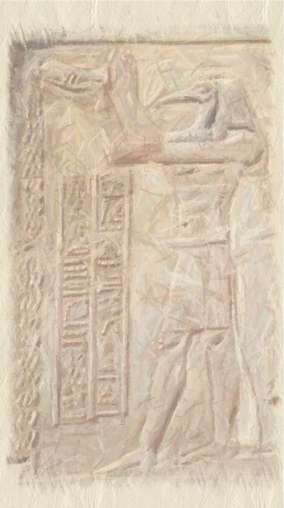
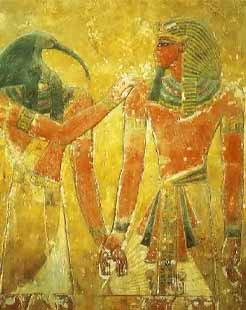
Thoth and Osiris
Thoth was Hermes - Ancient Egyptian Mythology - God and Goddess - Isis and Osiris- the mythology of creation and destruction - the resurrection of human consciousness.
The 6 inch disk speaks to me of an amulet or talisman. All roads link back to ancient Egypt for me - the geometry of the land representing the mythological tales of God and Goddess - 12 ethereal pyramids around one. As is above - The ethereal pyramid facing downward meeting 'So is below' - the Great Pyramid - forming the hourglass - or the illusion of TIME which is my work here!
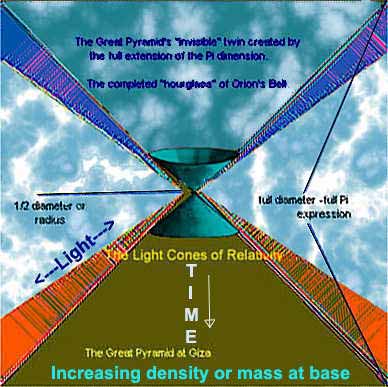
The bald head in Phaistos 58 and 61 bears two small circles imprinted on its cheek, one above the other as in our numeral 8. These appear to illustrate the meeting of the two big circles in the sky which led to its death. Two circles stacked just like these, the top one sometimes opened to look like the sickle of the new moon, were in early Classical Greece the emblem on the herald staff of Hermes. These circles became only later stylized as the entwined snakes of the caduceus that is now the logo of the medical profession. Hermes was the messenger of the Olympian gods and had also the surname "Psychopompus".
This means "Conductor of Souls" and identified him as the messenger from Hades, the realm of the dead. He summoned the expired there by laying this staff upon their eyes, the same way he put the living to sleep and woke them up at will. Then he guided the departing soul to the afterworld.
This placing of Hermes' two circles over the eyes of the deceased seems to survive in the folk custom to send off the dead with pennies on their eyes.
That the two circles appear here not on the eyes of the deceased but marked on his cheek may be artistic license on the part of the pictograph designer who placed them where they can be seen most clearly, without cluttering other lines.
This portrait of Hermes with his typical emblem is part of a larger scene by the painter Euphronios on a magnificent wine-mixing krater from about 520 BCE, now at the Metropolitan Museum in New York. Hermes functions there in his role as guide of the dead, a parallel to the Egyptian Thoth who weighed their souls and then guided them to Osiris.
To find this emblem from Classical Hermes' staff here on this head from the earlier Disk found in Crete should not surprise us either: gods usually kept the symbols which defined them, and Hermes was an ancient god. The thirteenth- century BCE Linear B tablets from Pylos mention him as "Hermahas" along with other gods known from Classical times.
Even farther back, Hermes shared many basic myths and functions with the age- old Egyptian god Thoth. Thoth's name meant messenger, just like the job description of Hermes, and he guided souls already in the Pyramid Texts where he was to "ferry the dead across the 'winding waterway' on his wings".
In one of the best known scenes from the Book of the Dead, Thoth also supervised the weighing of the heart in the "Hall of Judgment" through which all dead Egyptians had to pass before they could enter eternity. Hermes had the same job though he performed it himself: one of the Athenian black- figure vases, our earliest major corpus of mythological scenes in Greek art which dates mostly from the sixth century BCE, [the time line of Z or Zoroaster who is Thoth] shows him weighing souls with a beam scale identical to that of Thoth. It is all about bringing balance to the Game.
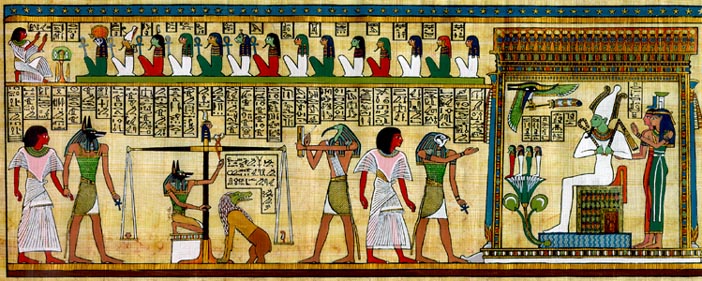
Hermes also "invented" in Greece a number of arts and instruments which had long existed in Crete and even earlier in Egypt where some of them were specifically ascribed to Thoth.
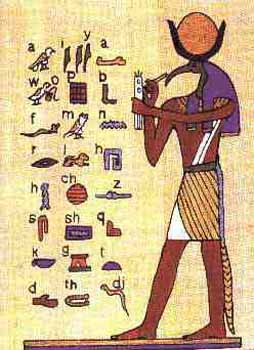
Thoth was the Ibis headed scribe - he who wrote the story of our reality. Examples are the latter's above mentioned gifts of astronomy, reckoning, board games, and writing, as well as weights and measures which Hermes claimed also to have brought.
The two circles as time limit for the sun The emblem Thoth wore for his function as "Measurer of Time" [ also see Seshat] was a circular disk, the sign of the sun, with a crescent moon placed above it136 and very similar to the one Hermes wore on his staff. The meaning of this calendar-master's trademark was probably that the passage of lunisolar time was punctuated by the "Joining of Sun and Moon" which defined the cyclical life of the sun.
If the two joined circles on Hermes' staff depict a "joining" of the sun with the moon, as in the crown of Thoth the measurer of time, then we should not be surprised to find midway between Egypt and Greece the common emblem of this Egyptian and Greek mortuary god in the two circles on the bald head from Crete.
As usual for such shared emblems, the two circles on Hermes' staff seem to have meant the same as those above Thoth's crown, and those same circles on the Old Philistine bald head's cheek are likely to have symbolized the same. In the context of the Disk, they seem to imply the end of the time allotted to the "sun head", and so to confirm again the interpretation of the bald head as expression of the long-haired one's death at the end of his cycle.
The two circles on the bald head's cheek may then stand as shorthand for something like "The 'Great Year' between the meetings of new sun and new moon is over and time has run out for the old sun. Thoth-Hermahas marks this event on the dead sun with his emblem as measurer of time, and he guides the sun's soul into the afterworld".
This mark on the Phaistos bald head in the field of death matches again perfectly the timing of death in Senet right after a joining of sun and moon, except that the Egyptians used a different year-length for their calculations and so came up with a different period between such meetings. The similarity despite the difference only confirms that both examples were based on the same idea.
The Cretans of the Disk's New Palace Period did not live in isolation but traded far and wide, particularly with their rich and nearby neighbor to the south. Their island lies less than a week by sail from Egypt in good weather, and Odysseus could claim plausibly in one of his tall tales that he had covered that distance in five days.
Crete and Egypt are so close that at Alexandria in the Ottoman era, sailboat cargoes included snow exported from Crete and butter brought to it. Many traces of intense early contact between the two regions survive, including the Cretan domestic cats which descended from Egyptian sires, not from the native wild cats.
Already centuries before the Disk, the Cretan wall painters colored males red and females white to yellow, in the same arbitrary convention as their Egyptian colleagues, and the Cretan seal-makers used designs closely parallel to those found in Egypt.
Their work included even some Cretan-styled seals with Egyptian gameboards on them, so there is no doubt that Senet was well known and highly esteemed in the culture that left us the Disk. The Egyptian influence in Crete was so strong that several of the levels at Knossos are dated by the Egyptian artifacts in them. Even the base of a 12th Dynasty Egyptian dignitary's diorite statuette came to light at Knossos, in a deposit from a couple of centuries before the Disk.
And after the time of the Disk, both queen Hatshepsut (1473 to 1458 BCE) and king Thutmosis III (her successor to 1425 BCE) received formal embassies of Cretans in their Theban capital, as depicted in tombs of their nobles.
Slightly later the Linear B tablets from Knossos mention an "Aiguptios".
Most revealing for the transfer of ideas, more than any imported artifact or written mention, is a clay sistrum of apparently Cretan manufacture found in the cemetery of Arkhanes Phourni, buried about four centuries before the Disk. This clear imitation of a uniquely Egyptian ritual instrument and its presence in the funerary building imply knowledge of its use and purpose. It thereby proves that the Cretans had bought in their travels not only material objects but also some of the symbolism they encountered in Egypt.
The sharing of symbolism between Crete and Egypt was particularly intense around the time when the Disk got buried. The Hyksos kings who ruled Egypt from about 1640 to 1540 BCE adorned their palaces with unmistakably Cretan-style wall paintings of maze-like meanders and other motifs from the Aegaean.
In one spectacular fragment from the Hyksos capital Avaris, a young person with the typical long and curly black locks well known from Cretan paintings clasps the neck of a bull from above.
The parallel to the famous "bull- leaper" frescoes from the contemporary palace in Knossos is so pronounced that some scholars suggest these murals may express a dynastic or religious connection between Hyksos kingship and the rulers of Knossos, and in any case an interlocking of the beliefs in the two cultures.
Sources about Senet - This sharing of beliefs between Egypt and Crete makes the Egyptian game of Senet a valuable parallel to the proposed game on the Disk. Fortunately, a lot of information about Senet has survived in the form of actual gameboards, descriptions, and tomb paintings of Senet players with captions, and much of it has been conveniently assembled by two Egyptologists:
Edgar B. Pusch published a series of photographs and drawings with descriptions of all known Senet boards and Senet playing scenes in papyri and murals.
According to a scroll fragment which dates to Graeco-Roman times but seems to record a much earlier tradition, the 30 squares on the Senet board represented the 30 days in the standard ancient Egyptian calendar month, and more specifically the month of Thoth, the first month of the Egyptian year.
Thoth was a moon god and the god of science, astronomy, reckoning and writing, and in a myth the Greek philosopher Plato cites in Phaidrus, 274d, he was also the inventor of the board game which he bestowed on humanity together with those other arts.
The first Senet square was the "House of Thoth", and the festival of Thoth was indeed celebrated on the first day of his month which was also New Year's day. The thirtieth square stood for the last day of the standardized month "when the moon is invisible".
In Kendall's reconstruction, the last 16 squares, numbers 15 to 30, were the initially empty part of the track where the pieces lined up on the first 14 would perform their race to the end. The author of the fragment deemed it significant that the numbers of the stations on this active part of the track add up to 360, the number of days in the Egyptian twelve-month civil year
(The five additional days needed to stay approximately in tune with the solar year were not counted as regular time but remained outside its flow as birthdays of the gods.)
The most common version of the Senet board was laid out as a rectangular grid of 3 x 10 squares. U-shaped markings at the ends of two rows in an Old Kingdom mural indicate that the pieces turned there, "as the ox plows", to follow a continuous path with two U-turns. Like the pattern of travel up and down the Nile, that path went up the length of the board and down its middle and then up again on the other side.
Crude copies of boards for Senet pop up already in pre-dynastic graves from before 3100 BCE, and the game remained during the entire pharaonic period an important funerary gift for rich and poor. Kendall cites several examples of humble graves in which, aside from some pottery and a few beads, a Senet board and its pieces were the only other objects buried with the dead.
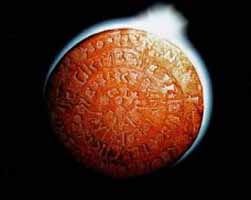

From the Pyramid Texts
- Breaking the Egg and Splitting the Iron
Rod of Balance - Light Rod
Iron - Electromagnetic Energies - Polarities
Rebirth in the nest of Thoth
Osiris and Isis - Resurrection and Rebirth




2 comments:
An actions report of a manager of the ancient Phaistos commercial center
The famous Phaistos Disc is a printed, per paragraph, synoptic report of a manager actions from the Phaistos commercial center. The spirals, for technical reasons, are starting with guide the edge of the disc, from the periphery to the center, and the inscription, again for technical reasons, begins reversely.
The Phaistos Disk, the Column from Abydos, the Rosetta’s Stone, the plate from Egkomi, the plate from the Athena's sanctuary of the Idalion and the plate of Kortona are some written reports or publications current accounting's and regulatory acts for the king's or administration's or municipality's informing.
Read newest for Human Written Word!
When talking about the Human Language we mean the Universal Language, which we will discover and, studying, we will approach through dialects of nations and peoples.
http://bouzanis.blogspot.gr/2014/11/read-newest-for-human-written-word.html
Post a Comment